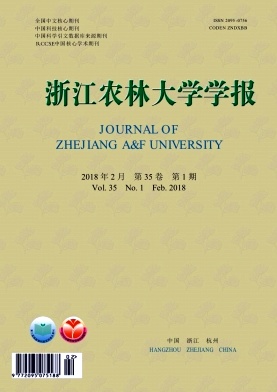-
交趾黄檀Dalbergia cochinchinensis属豆科Leguminosae黄檀属Dalbergia,俗称大红酸枝、老挝红酸枝、柬埔寨檀、老红木等,其木材在国家标准GB/T 18107-2000《红木》中被归为红酸枝木类[1],是一种具备光泽、高强度、耐腐蚀、加工性能好的高档名贵木材。交趾黄檀主要分布于中南半岛22°~10°N的区域,遍布泰国、柬埔寨、老挝境内的大多数地区,越南南部地区也有少量分布。交趾黄檀是一种速生半落叶乔木,明清时期作为宫廷专用的“三大贡木”,主要用作红木家具、乐器、雕刻等用材[2]。鉴于交趾黄檀具有较高的经济价值,近年来学者开展了交趾黄檀树种的相关研究,主要围绕着利用光谱、色谱仪器及分子生物学技术对交趾黄檀树种的鉴别、心材化学成分的分离鉴定以及木材的结构构造、物理性能等研究工作[3-10],而在种源选择和培育领域研究较少。种子作为林木的繁殖材料,其数量的多少、质量的优劣与林业建设的成败息息相关[11-12]。因此,良种选育首要工作就要开展种源试验。本研究以来自泰国、柬埔寨、中国等10个不同产地25个家系的交趾黄檀的种子为研究对象,对其种子特征以及在中国广东广州、广东阳江、福建漳州、海南乐东等4个地区对各种源的种子发芽率开展相关研究,旨在为交趾黄檀在中国不同栽植区域进行引种和遗传改良等科研工作提供一定的理论支撑。
HTML
-
本试验研究所用交趾黄檀种子来自于柬埔寨、泰国和中国等10个种源的25个家系,其中Chachoengsao(北柳)种源包含10个家系,Prachin Buri(巴真)种源包含7个家系,其余各种源地均为1个家系。种子采收于2014年12月。种源的相关信息详见表 1。
国家 种源 编号 纬度/(°N) 经度/(°E) 海拔/m 年均气温/% 年均降水量/mm 柬埔寨 马德望Battambong C-BTB 13.10 103.20 17 23.8~33.8 1 180 柬埔寨 磅湛Kampong Cham C-KC 11.99 105.46 21 25.0~33.9 2 150 柬埔寨 菩萨Pursat C-PS 12.47 103.89 39 25.0~30.8 1 350 柬埔寨 暹粒Siem Reap C-SR 13.37 103.84 18 23.8~33.8 1 180 泰国 北柳Chachoengsao T-CCS 13.69 101.08 7 22.0~31.8 1 420 泰国 巴真Prachin Buri T-PB 14.04 101.66 19 24.1~34.3 1 840 泰国 孔敬Khon Kaen T-KK 16.44 102.84 169 22.5~32.7 1 304 泰国 呵叻Nakorn Rachassima T-NR 14.98 102.10 184 23.2~33.0 1 161 泰国 彭世洛Phitsanulok T-PSL 16.82 100.27 50 22.9~33.2 1 412 中国 阳江Yangjiang C-YJ 21.86 111.98 4 20.0~26.5 2 040 Table 1. Information of various seed provenances
-
选取种子的长度(纵轴)、宽度(横向最大宽度)、厚度以及千粒重作为形态指标。随机抽取种子30粒·家系-1,并用精度为0.01 mm的游标卡尺分别测量其种子长度(L),种子宽度(W),种子厚度(T),各3次重复,共测量种子数为90粒·家系-1。种子千粒重的测量参照GB 2772-1999《林木种子检验规程》[13],采用百粒法,重复3次,用电子天平称量。种形系数=种子长度(L)/种子宽度(W)。多家系种源值以家系间均值计算。
-
于2015年8月分别在广东广州、广东阳江、福建漳州、海南乐东等4个地区的室外苗圃进行试验。试验前,将随机挑选出来的各个家系的供试种子在25 ℃室温下浸水24.0 h,然后供试种子用m(高锰酸钾):m(蒸馏水)=3:1 000水溶液消毒0.5 h,再用蒸馏水洗净,播种于已编号的育苗盘内。播种基质均为同种规格的河沙,采用随机区组设计,随机选取种子50粒·家系-1,4次重复,共计种子200粒·家系-1。每天定时观测种子发芽状况,定期补水,保证基质湿润,并做好发芽数的记录工作,连续2 d没有新增种子发芽数时结束统计[13]。发芽率=(已发芽种子数/观测的种子总数)×100%。变异系数=(性状标准偏差/性状平均值)×100%。多家系种源值以家系间均值计算。
-
按种源单因素进行方差分析检验种源差异显著性,按照种源和播种地双因素检测不同种源在不同播种地差异的显著性;利用最小显著差法(Duncan,P<0.05)进行不同种源以及不同播种地间种子形态特征/发芽率差异分析;通过种子形态特征以及种子发芽参数与产地地理气候因子的简单相关(Pearson相关)分析以揭示和阐明交趾黄檀的地理变异模式及其气候生态学基础,利用平均连接法基于种子相关形态特征、发芽率、地理气候因子等指标进行聚类分析。所有分析都在SPSS 19.0中进行,并用SigmaPlot 13.0对分析结果进行作图。
1.1. 试验材料
1.2. 研究方法
1.2.1. 种子形态指标测量
1.2.2. 发芽试验及发芽率测定
1.3. 统计分析
-
在同一物种或品种内,种子的大小被认为是相对稳定的,而在种群间、种群内甚至个体间会存在一定差异[14]。由表 2可知:本试验测得10个产地的交趾黄檀种子平均长、宽、厚分别为6.71,4.03和1.12 mm,变幅分别为6.09~7.19,3.84~4.28和0.98~1.19 mm,千粒重达25.20 g,种形系数为1.67,形状呈椭圆形。千粒重最大的种子来自于柬埔寨的Pursat(菩萨)种源(33.76 g),最小的为中国的阳江种源(20.68 g)。不同种源的种子长、宽、厚变异系数最大的分别是Chachoengsao(北柳)种源(8.33%),Nakorn Rachassima(呵叻)种源(13.54%),Nakorn Rachassima(呵叻)种源(15.45%),说明这2个产地内的种子形状变异较大。不同种源间种宽随着种长的波动而呈现出较为相似的走势变化,种厚的变化趋势较平缓。不同种源种子长、宽、厚均表现出极显著差异(P<0.01),表明交趾黄檀产地间种子形态存在丰富的性状遗传变异。
种源 种子长度/mm 种子宽度/mm 种子厚度/mm 平均种形系数(L/W) 平均千粒重/g 长度±标准差 极小值 极大值 变异系数/% 宽度±标准差 极小值 极大值 变异系数/% 厚度±标准差 极小值 极大值 变异系数/% 马德望 6.09 ± 0.23 a 5.42 6.82 3.78 3.86 ± 0.13 a 3.58 4.29 3.37 0.98 ± 0.08 a 0.72 1.26 8.16 1.58 21.15 磅湛 6.19 ± 0.33ab 5.7 7.97 4.31 4.02 ± 0.17 ab 3.47 4.79 4.23 1.00 ± 0.06 ab 0.84 1.24 6.00 1.54 21.30 菩萨 7.19 ± 0.31e 6.49 8.08 4.31 4.28 ± 0.25 de 3.78 5.11 5.84 1.19 ± 0.12 b 0.97 1.53 10.08 1.68 33.76 暹粒 6.94 ± 0.41de 5.79 7.86 5.91 4.28 ± 0.25 bed 3.57 4.94 5.84 1.10 ± 0.11 b 0.84 1.39 10.00 1.62 33.71 北柳 6.48 ± 0.54bc 0.30 7.47 8.33 3.87 ± 0.38 de 0.32 7.28 9.82 1.14 ± 0.15 a 0.67 1.55 13.16 1.67 23.23 巴真 7.13 ± 0.45e 5.52 8.85 6.31 4.22 ± 0.31 de 3.27 5.32 7.35 1.14 ± 0.12 b 0.25 1.63 10.53 1.69 27.54 孔敬 6.64 ± 0.43bcd 5.42 7.59 6.48 4.00 ± 0.29 cd 3.24 4.59 7.25 1.14 ± 0.13 ab 0.87 1.41 11.40 1.66 24.98 呵叻 6.78 ± 0.46 cde 5.44 7.95 6.78 3.84 ± 0.52 bed 5.85 0.65 13.54 1.10 ± 0.17 a 1.49 0.74 15.45 1.76 23.52 彭世洛 7.02 ± 0.35de 6.16 8.17 4.99 4.06 ± 0.21 bed 3.64 4.72 5.17 1.10 ± 0.11 ab 0.95 1.44 10.00 1.72 25.72 阳江 6.29 ± 0.22ab 5.59 6.84 3.50 4.02 ± 0.18 abo 3.47 4.38 4.48 1.04 ± 0.09 ab 0.83 1.26 8.65 1.56 20.68 均值 6.71 5.47 4.03 6.69 1.12 10.34 1.67 25.20 极差 6.09~7.19 3.84~4.28 0.98~19 说明:同列不同字母表示差异显著(α=0.05)。 Table 2. Comparison of morphological characteristics of seeds from different habitats
-
交趾黄檀不同种源间、不同播种地间的种子发芽率各自均差异极显著(P<0.01),发芽率结果见表 3。10个种源种子的平均发芽率在阳江表现最好,为78%,并与其他3个播种地差异极显著(P<0.01),说明这批种子总体上较适宜在该地区进行播种。Prachin Buri(巴真)种源在4个地区的平均发芽率(83%),优于其他9个种源,Siem Reap(暹粒)种源和Phitsanulok(彭世洛)种源在4个地区的发芽结果较差。可见:Kampong Cham(磅湛)种源(79%)和Pursat(菩萨)种源(92%)的种子发芽率分别在广州、漳州达到了最高水平,Prachin Buri(巴真)种源在阳江、乐东也分别呈现最高的发芽率(90%和87%),这为以上4个地区交趾黄檀种源引种工作的初步筛选提供了一定理论参考。由表 3的多重比较分析进一步可知:Siem Reap(暹粒)种源、Phitsanulok(彭世洛)种源分别与其他8个种源的种子发芽率差异均显著,Battambong(马德望)种源与Prachin Buri(巴真)种源的种子发芽率达显著差异,而Yangjiang(阳江)、Khon Kaen(孔敬)、Nakorn Rachassima(呵叻)、Chachoengsao(北柳)、Kampong Cham(磅湛)、Pursat(菩萨)种源的种子发芽率两两之间差异均不显著。综上,Siem Reap(暹粒)和Phitsanulok(彭世洛)2个种源的种子整体适应性较差,Prachin Buri(巴真)种源播种品质较好。
种源 种子发芽率/% 播种地均值/% 阳江 漳州 乐东 广州 巴真 90 aA 79 aB 87 aA 76 aB 83 a 磅湛 86 ab 68 ab 81 ab 79 a 79 ab 菩萨 86 ab 92 ab 73 ab 65 ab 79 ab 北柳 87 abA 76 abBC 78 abBC 71 abC 78 ab 呵叻 87 ab 76 ab 74 ab 66 ab 76 ab 孔敬 79 abc 69 ab 65 b 65 ab 70 bc 阳江 77 bc 65 abc 69 b 58 b 67 bc 马德望 63 deAB 58 bcAB 51 bcB 77 aA 62 c 暹粒 54 e 51 d 43 cd 34 c 46 d 彭世洛 70 cdA 47 cdB 39 dC 27 cC 46 d 种源均值 78 a 68 b 66 b 62 b 说明:同一指标的数值后相同字母表示没有显著差异, 不同字母表示差异显著(α=0.05),小写字母表示种源内地点间差异,大写字母表示地点内种源间差异。 Table 3. Statistics of seed germination rate in 4 regions
-
交趾黄檀各指标相关性分析结果如表 4所示。不同种源间种子长与宽呈显著正相关(P<0.05),种子长度与厚度呈极显著正相关(P<0.01)。千粒重是衡量种子饱满程度的一个有力指标,种子饱满度可一定程度上表征其所含营养物质多少;种子发芽率可反映种子活力,而种子活力高低最主要由遗传性状决定[15]。在本试验中千粒重与种子的发芽率相关性均不显著(P>0.05),反而存在一定的负相关关系,这说明种子活力高低与种子形态大小之间并不存在绝对的正相关关系,与汪殿蓓等[16]、陈浩等[17]、邢丹等[18]的研究结果一致。不同种源种子在乐东的种子发芽率与其余3个地区均表现出了极显著正相关(P<0.01),尤其与阳江种源种子发芽率的相关系数最大(r=0.901),说明不同种源种子在阳江、乐东两地的发芽率变化趋势极为相似。种子性状、发芽率分别与产地的地理和气候因子相关性均不显著。
相关系数 种子长度 种子宽度 种子厚度 千粒重 经度 纬度 海拔 年均降水量 年均低温 年均高温 平均发芽率 发芽率(广州) 发芽率(阳江) 发芽率(漳州) 发芽率(乐东) 种子长度 1 种子宽度 0.686* 1 种子厚度 0.818** 0.452 1 千粒重 0.815** 0.840** 0.671* 1 经度 -0.45 0.068 -0.413 -0.264 1 纬度 -0.13 -0.16 -0.086 -0.361 0.572 1 海拔 0.171 -0.33 0.264 -0.056 -0.283 0.099 1 年均降水量 -0.29 0.125 -0.313 -0.386 0.569 0.269 -0.439 1 年均低温 0.307 0.391 0.071 0.459 -0.454 -0.884** -0.027 -0.130 1 年均高温 0.189 0.033 -0.032 0.183 -0.772** -0.738** 0.119 -0.325 0.713* 1 平均发芽率 -0.07 -0.14 0.220 -0.204 0.044 -0.239 0.078 0.380 0.179 -0.085 1 发芽率(广州) -0.45 -0.36 -0.183 -0.429 0.085 -0.329 0.013 0.301 0.213 0.061 0.861** 1 发芽率(阳江) 0.113 -0.15 0.366 -0.212 -0.069 -0.064 0.15 0.420 0.064 -0.131 0.902** 0.612 1 发芽率(漳州) 0.243 0.102 0.530 0.169 -0.006 -0.259 0.106 0.121 0.231 -0.190 0.893** 0.646* 0.814** 1 发芽率(乐东) -0.06 -0.08 0.205 -0.210 0.130 -0.146 0.037 0.524 0.093 -0.128 0.969** 0.785** 0.901** 0.826** 1 说明:**代表在0.01的水平相关, *代表在0.05的水平相关。 Table 4. Correlations among seed traits, geographical and climatic factors, and germination rate in 4 regions
-
将不同种源的种子进行一定程度的产区分类,对于引种、良种选育等科研工作十分必要。根据所测10个种源种子的相关形态特征、发芽率、地理气候因子等指标,对种子进行Q型聚类分析。聚类分析采用类平均法(average linkage),如图 1所示。在欧氏距离为16时,可将10个种源大体上分为三大产区。第1区包括来自柬埔寨Battambong(马德望)、Kampong Cham(磅湛)种源,泰国Chachoengsao(北柳)、Khon Kaen(孔敬)、Nakorn Rachassima(呵叻)种源的种子。本区种源的发芽表现较为接近,平均发芽率可达73%。第2区包括泰国的Prachin Buri(巴真)、Phitsanulok(彭世洛)种源和柬埔寨的Pursat(菩萨)、Siem Reap(暹粒)种源。本产区以Prachin Buri(巴真)、Pursat(菩萨)种源的种子质量和播种品质最优,引种驯化应优先考虑这2个种源。中国Yangjiang(阳江)种源的种子被单独划分为一区,这与该种源存在于较高的经纬度地区有一定关系。
2.1. 不同种源交趾黄檀的种子形态特征分析
2.2. 不同种源交趾黄檀种子在4个地区播种的发芽率差异分析
2.3. 不同种源交趾黄檀种子性状、地理气候因子及发芽率的相关性分析
2.4. 不同种源交趾黄檀种子的聚类分析
-
同一树种的遗传变异可体现在个体、组织细胞、分子等不同水平,使其发生的形态变异往往具有一定的生态适应意义[19-20]。种子作为受环境影响相对较小的繁殖器官,其形态是一种比较稳定的性状,可为林木的分类鉴定和遗传研究提供一定的参考[21-22]。种子大小的变异程度,会对种子的萌发和扩散有影响,与幼苗成活密切相关[23-24]。不同种源间交趾黄檀种子形态特征的试验结果表明,长、宽、厚存在极显著差异,种子长度、种子宽度、种子厚度具有6%~7%的变化幅度,千粒重的变幅高达16%,说明不同种源间的种子可能受自身遗传因素和外界环境因子的共同影响发生了形态上的变异,以更好地适应不同生境。种形系数变异幅度较小,表明这10个种源种子在形状上总体无明显差异。种子的表型性状与产地的地理、气候因子相关性不显著,表明交趾黄檀种子受制于环境因子影响较小,更多的表型变异可能源于自身遗传物质的差异性表达。因此,可以利用现代分子生物学技术对其种子进行相关性状的遗传改良。
交趾黄檀种子在不同种源间和不同播种地间的种子发芽率差异均极显著,而种子千粒重与种子发芽率的相关性不显著,因此,在选种时无须过多考虑千粒重这一指标。千粒重大小虽能评估种子饱满度及所含营养物质成分多少,但影响种子发芽品质的因素往往来源于遗传和环境双因子互作综合效应[25-26],具体的调控机制还需作进一步探究。种子在阳江地区的平均发芽率有着最优的表现,这可能与该地区的气候因素有关。阳江地区播种苗圃位于粤西南的广东省(阳江市)合山镇百盛园,21°58′49″N,112°10′34″E,气候属亚热带气候,年平均气温为23 ℃,最高气温38 ℃,最低气温0 ℃;年平均降水量为2 345 mm,无霜期为350 d,偶有低温霜冻。海南乐东尖峰岭地区年气温较高(25 ℃),然而年降水量仅为1 150 mm;广州、漳州两地冬天较冷,每年生长期比阳江短2~3个月。不同种源在阳江、乐东两地具有极相似的发芽率变化趋势,这说明在乐东地区通过对外界某一环境因子的调控,可达到在阳江一样的发芽品质。综合这批种子在广州、阳江、漳州、乐东的发芽结果,可为这4个地区进行交趾黄檀的适地适种选育提供一定理论指导。聚类分析将这10个种源的种子分为三大产区,据此选出Prachin Buri(巴真)和Pursat(菩萨)两大优良种源种子。








 DownLoad:
DownLoad: